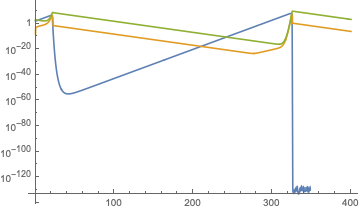I am trying to numerically solve a simple delay ODE in mma for the first time. I think this is likely a simple fix.
I first tried to solve system as ordinary differential equation system for up to 𝑡=l. And then use these solutions as history functions for the delay differential equation system. I keep getting the error: NDSolve::dvnoarg The function na appears with no arguments
ClearAll["Global`*"]
c = 200; Q = 4; P = 1.92*10^-6; ea = 2.6*10^-6; ga =
6.24*10^-8; l = 0.5; ba = 98; pr = 0.2;
sol0 = NDSolve[{
r'[t] == pr (c - r[t]) - P r[t]/(Q + r[t]) (na[t] + ma[t]),
na'[t] == P r[t]/(ea (Q + r[t])) na[t] - pr na[t] - ga
na[t] p[t],
ma'[t] == ga na[t] p[t] - pr ma[t],
p'[t] == -pr p[t] - p[t] ga na[t] ,
r[0] == 1000, ma[0] == 0, na[0] == 100, p[0] == 1000},
{r, na, ma, p}, {t, 0, l}][[1]];
sol = NDSolve[{
r'[t] == pr (c - r[t]) - P r[t]/(Q + r[t]) (na[t] + ma[t]),
na'[t] == P r[t]/(ea (Q + r[t])) na[t] - pr na[t] - ga
na[t] p[t],
ma'[t] == ga na[t] p[t] - pr ma[t] -
Exp[-pr l] ga na[t - l] p[t - l],
p'[t] == ba Exp[-pr l] ga na[t - l] p[t - l] - pr p[t] -
p[t] ga na[t] ,
r[0] == 1000, na[t /; t <= l] == sol0[[2]], ma[0] == 0,
p[t /; t <= l] == sol0[[4]]},
{r, na, ma, p}, {t, 0, 100}][[1]];
Any suggestions are much appreciated.


sol0[[2]]andsol0[[4]]. You probably want(na[t] /. sol0), or to useNDSolveValueforsol0(the firstNDSolvecall). $\endgroup$